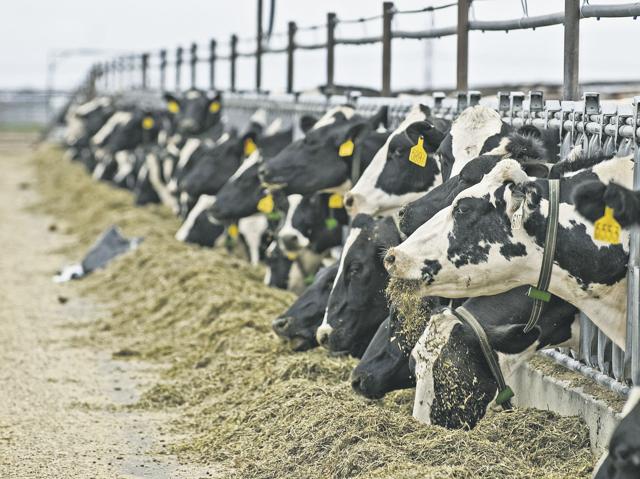
Butter stocks fell in September compared to August but were up 13.6% from a year ago.
The USDA’s latest Cold Storage report had Sept. 30 butter holdings at just under 303 million pounds, down 21.4 million pounds or 6.6% from the August count, which was revised up 1.1 million pounds, and was up 36.4 million pounds or 13.6% from September 2023.
HighGround Dairy points out that this is the eighth consecutive year-over-year gain in butter inventories and the largest since May 2023.
American type cheese stocks slipped to 782.8 million pounds, down 10.8 million or 1.4% from the August level, which was revised 6.3 million pounds lower, and they were down 68.4 million pounds or 8.0% from a year ago.
The “other” cheese category stocks, at 570.4 million pounds, were down 7.2 million pounds or 1.2% from the August count, and down 40.2 million pounds or 6.6% from a year ago.
The total Sept. 30 cheese inventory slipped to 1.375 billion pounds, down 18.3 million pounds or 1.3% from August and 108.2 million pounds or 7.3% below a year ago.
The report is viewed as bullish for cheese and bearish for butter.
Class I down 64 cents
The November Federal order Class I base milk price was announced at $22.53 per hundredweight, down 64 cents from October, $2.78 above a year ago, and equates to $1.94 per gallon, up from $1.70 a year ago.
The 11-month Class I average stands at $20.25, up from $19.15 at this time a year ago, but compares to $23.76 in 2022.
Culling remains below 2023
The USDA’s latest Livestock Slaughter report showed an estimated 210,400 head of dairy cows were slaughtered under federal inspection in September, down 20,300 from August, and 30,100 head or 12.5% below September 2023.
Slaughter for the week ending Oct. 12 totaled 51,400 head, unchanged from the previous week, but 4,200 or 7.6% below a year ago.
Year to date, 2,151,900 dairy cows had been culled, down 338,900 head or 13.6% from 2023.
Harvest ahead of a year ago
The U.S. corn harvest was 81% completed, as of the week ending Oct. 27, according to the USDA’s latest Crop Progress report. That’s up from 65% the previous week, and compares to 68% a year ago and is 17% ahead of the five-year average.
Soybeans were 89% harvested, up from 81% the previous week, 7% ahead of a year ago, and 11% ahead of the five-year average.
Dairy prices mixed
CME block Cheddar closed Friday at $1.90 per pound, down 2.50 cents on the week but 17 cents above a year ago, as traders anticipated Friday afternoon’s September Cold Storage report.
The Cheddar barrels finished at $1.87 per pound, 14 cents lower, 18.75 cents above a year ago, and at a typical 3 cents below the blocks. Sales totaled 5 loads of block and 9 of barrel for the week.
The blocks were unchanged Monday but lost a half-cent Tuesday on six trades, slipping to $1.8950.
The barrels were also unchanged Monday but gained 2 cents Tuesday on an unfilled bid, climbing to $1.89.
Midwestern cheesemakers report retail cheese demand remains wholly bullish, according to Dairy Market News. Customers were adding to orders and some are oversold. Others say ordering was in line with seasonal expectations.
Cheese plant downtime remains a part of the story for scheduled maintenance.
Milk availability is steady and Mid-week prices ranged from Class III to $2.00 over. A year ago, they ranged 25 cents to $2-over, according to DMN.
Demand for Class III milk is generally strong from western cheese makers. Some continue requesting additional loads, but fewer loads are available in some parts of the region.
Cheese production is steady to strong. Sellers convey that domestic demand is neither robust nor sluggish. Export demand is steady as domestic prices continue to hold some competitiveness against global prices.
The Oct. 24 “Daily Dairy Report” had good news for U.S. cheesemakers, stating that “Mexico will continue to expand milk production next year, but most of the additional milk will be processed by bottlers.”
“Cheese imports will continue to grow, according to a Global Agricultural Information Network report,” and the DDR says “Mexico buys nearly all its imported cheese from the United States.”
Pizza is the second most consumed food item in Mexico, behind tacos, according to the report and U.S. shredded cheeses are the most popular topping. Cheese consumption in Mexico is forecast to grow 2% this year, according to the DDR, and 4% next year.
Mexico is already the U.S. No. 1 cheese customer.
CME butter climbed to $2.73 per pound last Monday, highest since Oct. 1, then fell to $2.65 Thursday, and closed Friday at $2.6950, up 3.50 cents on the week but 49.75 cents below a year ago. There were only 15 loads traded last week, following the previous week’s record 161 loads.
Monday’s butter was down 2 cents on 3 trades. It regained 1.50 cents Tuesday on a trade, climbing back to $2.69 per pound.
Seasonal butter plant downtime continues. Some is scheduled while others are dealing with unexpected maintenance issues. Plenty of cream is moving through the region and multiples the previous week as low as 1.00 had not been reported last week, but were still relatively low for this time of the year.
Cream contracts for next year are being worked through and are reportedly mixed on pricing. Butter demand is steady to increasing seasonally for retail, says DMN, as “the market is volleyed between bulls and bears after a notably busy week.”
Butter production is steady to strong in the West. Some manufacturers were running heavier due to churn maintenance slotted to start in November. In some cases, butter manufacturers prefer to sell excess cream, if possible, rather than put it into churns.
Cream is readily available. Domestic butter demand is mostly steady. Exports were steady as domestic prices continue to be competitive with international prices, according to DMN.
Nonfat dry milk closed Friday at $1.3750 per pound, down a half-cent on the week but 17.75 cents above a year ago, on 32 sales for the week.
Traders left the powder unchanged Monday but 10 loads were traded. They took it up 1.25 cents Tuesday to $1.3875 with 12 more loads exchanging hands.
The dry whey saw its Friday close at 60.50 cents per pound, up a half-cent and 20.50 cents above a year ago, with 13 sales put on the board for the week.
The whey remained at Friday’s close Monday and Tuesday.
Higher Pulse
Tuesday’s Global Dairy Trade Pulse saw 4.8 million pounds of product sold, up from 4.7 million in the last Pulse.
StoneX reported “Pulse prices were higher with whole milk powder hitting $3,610, up 2.1% from the Pulse auction last week. This is the highest Fonterra C2 regular WMP price since September 2022.”
“Skim milk powder was up 2% to $2,860 ($1.30/lb.). That was the highest level since May 2023. The strength seems largely driven by the demand side (China) as supply in New Zealand (and the other major exporters) has been improving.”
HighGround Dairy stated that, while the Instant WMP price increased, compared to the previous auction, only 34.2% of the total on offer was sold.
You can now read the most important #news on #eDairyNews #Whatsapp channels!!!
🇺🇸 eDairy News INGLÊS: https://whatsapp.com/channel/0029VaKsjzGDTkJyIN6hcP1K

























